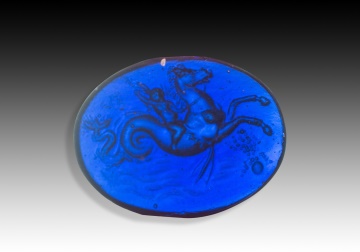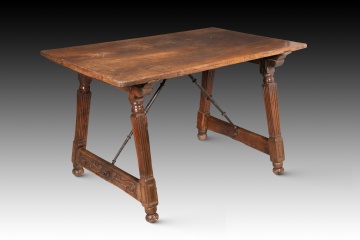
-
The Naked Maja. Framed engraving. DEZARROIS. Paris, France, circa 1900. Engraving inspired by the famous Goya painting which, when it was made, was in the Royal Academy of Fine Arts of San Fernando in Madrid (Spain). As indicated below the image, it is the work of Antoine-François Dezarrois for an article about the painter in La Revue de l'art ancien et moderne, a periodical founded by Jules Comte in 1987 and directed by him (until his death in 1912).
· Size: 41x1,5x31,5 cms. Int 21x14 cms
DECORATIVE ANTIQUES
Ref.: Z4624
-
Souvenir. Framed engraving. TORRAS Y ARMENGOL, Francisco. Spain, 1874. Framed engraving by Francisco Torras y Armengol (Tarrasa, 1832-Madrid, 1878) that was part of the collection El Grabador al Aguafuerte (The Etching Engraver), put on sale in the fourth issue of 1874, published by the Society of Artists and with the Calcografía Nacional as the printer. The copper plate is preserved in the Calcografía Nacional.
· Size: 42,5x2x57 cms. int:13,5x18,5 cms.
DECORATIVE ANTIQUES
Ref.: Z4675C
-
Policasta and Telemachus. Framed engraving. TORRAS Y ARMENGOL, Francisco. Spain, 1874. Print by Francisco Torras y Armengol (Tarrasa, 1832-Madrid, 1878) that originally formed part of El Grabador al Aguafuerte (The Etching Engraver), on sale in the second issue of 1874. The copper plate is preserved in the Calcografía Nacional, which appears as the printer of the work. The publisher was the Society of Artists. Telemachus, son of Odysseus and Penelope, is a character in the Odyssey and, according to some sources, the father of Persepolis and the poet Homer with Polycasta, daughter of Nestor.
· Size: 42,5x2x57 cms. int:17,5x25 cms.
DECORATIVE ANTIQUES
Ref.: Z4675E
-
Sermon. Framed engraving. Spain, 1874. With hand inscription (below, right). Print created by Juan José Martínez de Espinosa (Sanlúcar de Barrameda, 1826-Madrid, 1902), which originally formed part of the first volume of the collection El Grabador al Aguafuerte, released in the sixth issue of 1874. The copper plate is preserved in the Calcografía Nacional, where the artist acted as printer. The publisher is the Sociedad de Artistas.
· Size: 55,5x1,5x41 cms. int: 28x22 cms.
DECORATIVE ANTIQUES
Ref.: Z4675I
-
Requiem. Framed engraving. Spain, 1876. Engraving created by Juan José Martínez de Espinosa (Sanlúcar de Barrameda, 1826-Madrid, 1902). Originally it was part of the third volume of the collection El Grabador al Aguafuerte (The Etching Engraver), released in the fourth issue in 1876. The copper plate is preserved in the Calcografía Nacional, which acted as a printer. The Society of Artists participated as editor.
· Size: 58x1,5x43,5 cms., int: 28x22 cms.
DECORATIVE ANTIQUES
Ref.: Z4675K
-
Dining table. Carved wood. 20th century, following antique models. Dining table with a rectangular top made of wood with four legs, turned and decorated with simple mouldings and balustrade shapes, recalling examples of certain European schools common in the 19th century.
· Size: 75x160x90 cms
DECORATION
FURNITURE;CLASSIC
Ref.: JD001
-
“The Queen of the Woods. Star of Madrid”. Framed engraving. Hippolyte Louis Garnier (1802-1855). London, 1852. Framed print showing a young woman in a wooded natural landscape, reminiscent in certain details of common models in Rococo painting but with a more neoclassical taste and language. The title, the engraver and other details are at the bottom.
· Size: 57x3x70 cms. Int 40x52 cms
DECORATIVE ANTIQUES
Ref.: Z2352
-
Birds. Framed watercolor. 20th century. Watercolor showing two birds, perhaps thrushes, perched on the branch of a flowering tree, with no background in the composition, reminiscent of old biology books. The work is unsigned.
· Size: 21,5x0,1x31 cms
DECORATIVE ANTIQUES
Ref.: Z0790
-
Landscape. Oil on cardboard. Spanish School (P. Font), 1969. Signed (lower left); titled, signed and dated (back). Wooded landscape with a human figure (male due to his clothing) done with a treatment that shows clear influences from certain European pictorial avant-gardes of the 20th century (predominance of colour, absence of drawing, notable brushstrokes, colour, composition, theme, etc.).
· Size: 45x0,5x35,5 cms
DECORATIVE ANTIQUES
Ref.: Z4480
-
Death of Cleopatra. Framed engraving. Engraving by Jean Georg Wille, after painting by Gaspar Netscher. To Paris: chez l\\'Auteur Quay des Augustines à coté de l\\'Hotel d\\'Auvergne. Imp. 1754. Framed engraving with a historical theme very common in European art since the Renaissance. Cleopatra is seated in a luxurious interior, with a small snake in her hand, and accompanied by a maid, who brings her hands to her face in a gesture of of pain for the outcome of the story. In the lower area, more details of the work are carried (heraldic shield in the center, engraver, place, information about the work it is inspired by, etc.).
· Size: 44x1,5x61 cms. Int 29x40 cms
DECORATIVE ANTIQUES
Ref.: Z2355
-
Cardinal Infante Ferdinand of Austria. Framed engraving. 1870. National Chalcography (Spain); Gangoiti, Juan de (1816-1878); Maura Montaner, Bartolomé (1844-1926). Framed engraving based on the portrait of Cardinal-Infante Ferdinand of Austria as a hunter painted by Diego Rodríguez de Silva y Velázquez between 1632 and 1634, which is kept in the Museo del Prado in Madrid (Spain). This is an 1870 edition of the National Chalcography of Spain, of which the National Library of Madrid keeps the preparatory drawing.
· Size: 42,5x1,5x55 cms. Int 15x27,5 cms
DECORATIVE ANTIQUES
Ref.: Z4417
-
Raphael Mengs. Framed engraving. Spain, 1780. Engraving with a portrait of the neoclassical painter and theorist Anton Raphael Mengs (Aussig, Bohemia, March 12, 1728 - Rome, June 29, 1779). It belongs to a series dated 1870, apparently produced by the Calcografía Nacional, and is believed to have been inspired by an oil self-portrait by Mengs. Some sources indicate that it was a print engraved by Manuel Salvador Carmona.
· Size: 43x1,5x55 cms. Int 14x20 cms
DECORATIVE ANTIQUES
Ref.: Z4418
-
Mars. Framed engraving. Pineda. Spain, 1876. Engraving of the god Mars after the painting by Velázquez, preserved in the Prado Museum in Madrid. It is said to be print number 4 in the third volume of El Grabador al Aguafuerte, sold in the first issue in 1876. The engraver's surname was Pineda and the printer was Calcografía Nacional.
· Size: 42,5x1,5x57 cms
DECORATIVE ANTIQUES
Ref.: Z4421
-
Self-portrait by Esteban March (attributed). Framed engraving. MAURA Y MONTANER, Bartolomé. Spain, 1874. Engraving inspired by a painting considered a self-portrait that in the 19th century was believed to be by Esteban March (as indicated by the inscription), but which is now attributed to Orazio Borgianni. It was originally published as number thirteen, in the first volume of El Grabador al Aguafuerte, put on sale in the fourth issue of 1874. The copper plate is preserved in the Calcografía Nacional of Madrid (R. 5072), the printer of the work. It was published by the Society of Artists.
· Size: 43x1,5x58 cms. Int 22x27,5 cms
DECORATIVE ANTIQUES
Ref.: Z4423
-
Portrait of Joaquin Francisco Pacheco y Gutierrez Calderon. Framed engraving. Spain, 19th century. Framed engraving showing Joaquín Francisco Pacheco y Gutiérrez Calderón (Écija, 1808-Madrid, 1856), a Spanish jurist, politician, journalist and writer, following a portrait by a painter named Lozano.
· Size: 43x2x55 cms. Int 18x24 cms
DECORATIVE ANTIQUES
Ref.: Z4413
-
“Christ the Savior”. Oil on canvas. Spanish school, 17th century. Damage Oil on canvas with a three-quarter view of a bearded Christ, blessing with one hand and holding the Orb of Creation crowned by a cross in the other, in an iconography known as Christ the Savior of the World and already used by masters such as Pedro Berruguete, Leonardo da Vinci, El Greco, etc., both in Europe and South America.
· Size: 53x2x67 cms. int: 45x59
DECORATIVE ANTIQUES
Ref.: Z0264
-
Desk. Carved wood, metal. 20th century, following older models. Desk with six legs with rollers made of wood with a lemon-coloured finish and marquetry in other colours on the legs, fronts, drawers and doors (plant motifs, bows, scrolls, etc., with a classicist influence). It has five drawers under the table, finished in leather and enhanced with a second body with three doors and a total of eight drawers. Stylistically, it follows 19th century models, close to the French school.
· Size: 150x78x108 cms.
DECORATION
FURNITURE;CLASSIC
Ref.: D133
-
Coffee table frame. Carved wood with white finish. Rectangular carved wooden structure with light cabriole legs and smooth mouldings combined with plant elements, with a marked antique inspiration. The shape and decoration are reminiscent of European school work common during the 19th century.
· Size: 94x61x48 cms
DECORATION
FURNITURE;CLASSIC
Ref.: Z2716
-
Sold

Intaglio or cameo, Hippocampus. Glass. Possibly Italy, 19th century. A sea monster, called a hippocampus and usually associated with the god Poseidon, can be seen, with the lower part (chest down) in the shape of a fish and the upper part of a horse. Note the appearance of a rider and waves alluding to the sea. These types of pieces were created in large numbers as they were highly appreciated as souvenirs by travellers on the Grand Tour, and several were often collected to make collections.
· Size: 1,2x0,2x1,6 cms
DECORATIVE ANTIQUES
Ref.: ZF128425
-
Sold

Buffet table. Walnut, iron. Spanish School, 16th century. Walnut table with a rectangular top projecting on the sides, iron fasteners decorated with discs, and stipe legs in the shape of coved columns joined at the bottom by a carved jamb with architectural elements ending in volutes, resembling in shape the so-called "Saint Anthony" legs. Walnut wood was the most common in antique Spanish furniture, and the lack of decoration in the upper area is due to the fact that these pieces of furniture were designed to be "dressed" (covered with a cloth). Compare, in general terms, the so-called Inquisition Buffet, dated around 1600 and housed in the National Museum of Decorative Arts in Madrid. A table with similar decoration, dating to the late 16th century, is also held in a private collection. These carved decorative elements on the legs show a clear classicist influence, which is why it is thought to be associated with the Renaissance.
· Size: 132x85x81 cms.
ANTIQUES
Ref.: ZF1296
-
Seating. Wood, upholstered. 20th century, following the French school. Set of seating furniture with antique-style textile upholstery and carved wooden frame decorated with plant elements and openwork areas (armchair), composed of a three-seater armchair and four high-backed armchairs with partially upholstered arms. The shapes and decoration are inspired by French models common during the 19th century.
· Size: 177x71x113 cms Butacas: 77x65x108 cms
DECORATIVE ANTIQUES
Ref.: E1993A
-
Desk table. Following old models. Desk with a rectangular top divided into three areas by three textiles, with four drawers on each side (in the structures on legs) and another one in the centre, with decorated metal handles; the other front has two doors and two drawers on the sides and another wider one in the centre. The decoration, with architectural elements reminiscent of classicism and simple mouldings, shows a clear influence from 19th century models.
· Size: 90x180x75 cms.
DECORATION
FURNITURE;CLASSIC
Ref.: JW003
-
Chest. Carved wood, metal. Spanish school, 16th century. Rectangular casket with a flat lid decorated on the outside with a series of figurative reliefs in a symmetrical arrangement with a theme and lines of clear Renaissance influence (framed and enhanced with smooth mouldings, on each front there are two grotesques facing each other or back to back, with a candlestick or central motif as the axis).
· Size: 19,5x14x11 cms.
ANTIQUES
Ref.: ZF1289
-
Bed. Carved and turned wood. 20th century, following ancient models. Bed frame composed of a headboard and footboard made of carved and turned wood, creating architectural and plant motifs reminiscent of classical elements with Baroque influences (Solomonic shapes), following common examples in certain areas of Spain and Portugal.
· Size: 149x187 cms. para 130x190 cms.
DECORATION
FURNITURE;CLASSIC
Ref.: V200